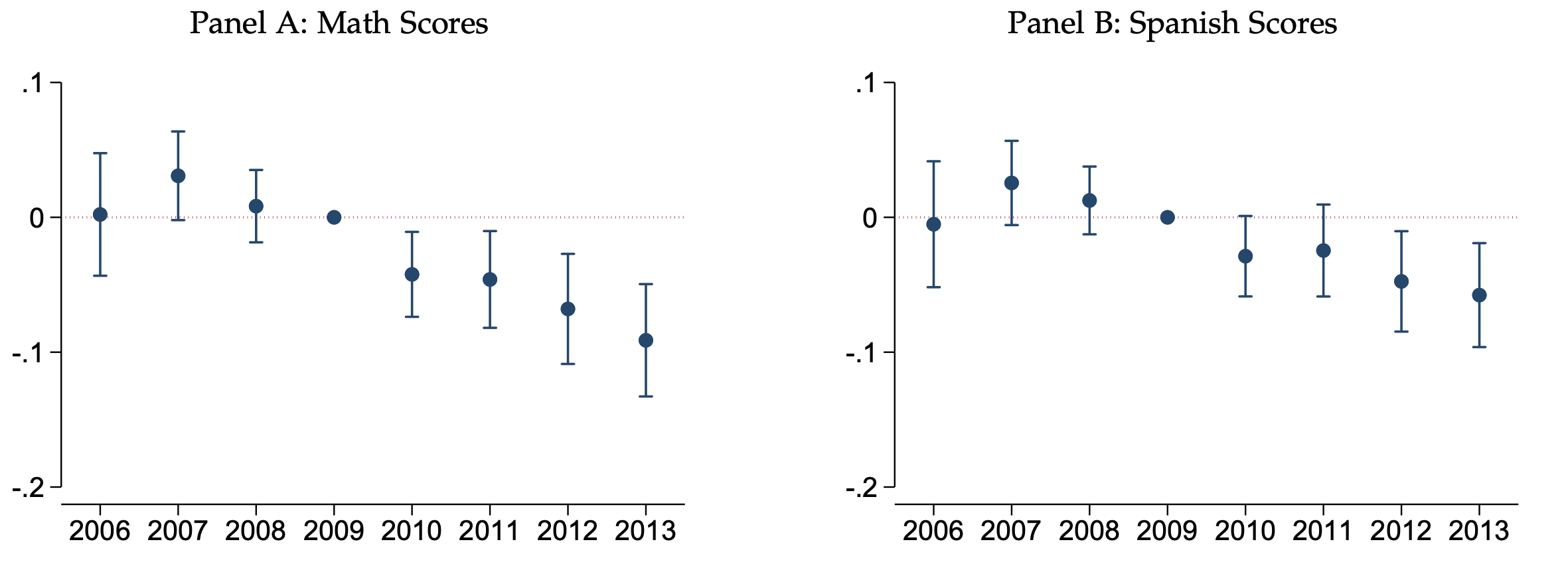Exactly how big of a deal is lead poisoning for children’s learning? Last year we published a CGD working paper with a systematic review and meta-analysis of observational studies, showing big effects. Though these studies are observational, we argued that we can interpret them as causal effects, due to a combination of 1) a clear biological mechanism, 2) experimental studies with animals, 3) quasi-experimental studies with people in the US and Sweden, and 4) the minimal impact of relevant controls in observational studies.
But this still left us without direct causal evidence of an effect of lead on children’s learning in developing countries, which we might expect to be different than effects in richer countries. Until now.
In one new paper, “Toxic Recycling: The Cost of Used Lead-Acid Battery Processing in Mexico”, Erin Litzow, a PhD candidate at the University of British Columbia (and on the job market!), along with Bianca Cecato, Tatiana Zarate-Barrera, and Mauricio Romero, study the effect of lead-acid battery recycling in Mexico. They find that children exposed to a new source of lead exposure from battery recycling plants score 0.05 - 0.09 standard deviations worse on standardised high school exams. This paper builds on an earlier study by Shinsuke Tanaka, Kensuke Teshima, and Eric Verhoogen that uses the same source of exposure to estimate negative causal effects on child birth weight.
Figure 1: Effects of being close to a lead-acid battery recycling plant in Mexico

In a second new paper, “The Hidden Costs of Recycling: Lead Exposure and Student Learning”, Gerald Ipapa, a PhD candidate at the University of Delaware (also on the job market!) looks at the effects of new lead-acid battery recycling in Kenya on primary school test scores, finding an effect of around 0.05 standard deviations for those within 4 km of a site.
Figure 2: Effects of being close to a lead-acid battery recycling plant in Kenya
Both studies estimate causal effects using a difference-in-difference approach, comparing trends before and after exposure in affected areas with trends before and after the same time point in unaffected areas. This approach allows places next to recycling plants to be different to other places before the exposure started, but assumes that the trends in test scores would have been similar in the absence of exposure.
How do these effect sizes compare with those from our meta-analysis? This comparison is difficult as neither Litzow et al or Ipapa have actual data on blood lead levels. Instead, they estimate the “reduced-form” effect of being exposed to battery recycling on learning. By contrast our meta-analysis focused on studies comparing measurements of actual blood lead with learning. One way of drawing a comparison though is looking at the average lead levels near battery recycling plants, and thinking about what levels we would need to see in Mexico and Kenya for our estimates to align.
One recent study of soil lead near battery recycling plants in Mexico found a median level of 1,035 parts per million. According to the CDC, this would translate to an increase in blood lead levels of 3 - 7 mcg/dl. In Kenya, a 2011 study found soil lead levels outside battery recycling plants with a median of 550 parts per million. We can then combine average baseline blood lead levels in Mexico and Kenya with the increase in blood lead that we would expect based on observed soil lead levels, with our meta-analytic estimate of the effect of blood lead increases on test scores. Using our modelled parameter (see here for calculations), we would expect to see effects on learning of 0.10 - 0.17 in Mexico and 0.06 - 0.11 in Kenya. This is very close to those actually estimated in the new causal studies by Litzow et al in Mexico (0.05 - 0.09) and Ipapa in Kenya (0.05). This is reassuring, but to do better in future, we need more investment in more blood lead testing in developing countries (more on that to come soon from CGD).
The sad coda to the Litzow et al study is that the cause of the increase in lead exposure in Mexico was an increase in exports from the US. Improved environmental regulations in the US meant that firms responded by moving recycling south to Mexico. A cleaner environment might be good for US citizens, but if it’s just exporting the problem to its poorer neighbour, we need to figure out a policy solution.
Thanks to Justin Sandefur for comments on a draft of this blog.
CGD blog posts reflect the views of the authors, drawing on prior research and experience in their areas of expertise.
CGD is a nonpartisan, independent organization and does not take institutional positions.








